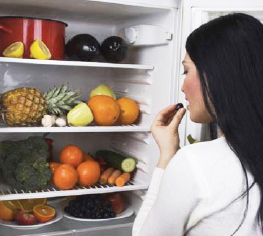The refrigerator has always been a place to safeguard foods, while maintaining its freshness and shelf life. But, does it give you the assurance that your foods are perfectly safe to be consumed?
What ‘License’ Does Your Fridge Possess?
Have you ever seen mold on your fruits, vegetables or leftovers? If yes, your fridge may possess the ‘license to harm’. This license allows your fridge to open up opportunities for the growth of food microorganisms on your foods that has the potential to cause:
- Spoilage. Your food may deteriorate and develop unpleasant odours, tastes and textures caused by microorganisms such as bacteria, yeast, or mold as a result of poor refrigeration practices. You can do a great deal to prevent the growth of these microorganisms with good refrigeration.
- Food-borne illnesses. Some microorganisms in food may be harmful to us, and especially to our children as their immune systems are still maturing. You have to be vigilant as these microorganisms can sometimes cause serious problems.
Is Your Fridge a Defender of Food?
Know your basics to keep your family from being affected by food-borne microorganisms. Here are some useful tips for healthy habits in the use of refrigerators.
- Keep foods chilled at proper temperatures. Bacteria and fungi grow well in temperatures ranging from 4-60°C. Proper refrigeration will prevent growth of such microorganisms. Therefore, ensure the refrigerator temperature is always at 4-5°C. The freezer temperature should be set at -18°C.
- Never overfill your fridge. This will prevent good cold air circulation and promote pockets of warm air.
- Beware of cross-contamination. This happens when bacteria spreads between food, surfaces or equipment. It will most likely occur when raw food touches or drips onto cooked food. Use plastic bags, covered containers, aluminium foil or place foods on a plate covered with clingwrap to prevent raw juices from dripping or food contact.
- Store them right. This prevents microorganisms from multiplying and preserves food texture. Ensure that the various types of food are placed in the correct storage areas. Fish, poultry, meat and frozen food should be stored frozen in use-size portions if you’re not cooking it the next day. This avoids repeated thawing and refreezing which encourages build-up of microorganisms. The top shelf is for storing butter, cheese, preserves, salad dressings, sauces and eggs. The middle shelves should be for cooked and leftover foods and salads. The bottom shelf is for raw meat and poultry which are left to thaw before cooking. The vegetable drawer, the warmest part of the fridge (10-12°C) is only used for unprepared fruit and vegetables. Liquids like fresh fruit juices should be consumed within six hours even when they are stored in the refrigerator.
- Clean and defrost your fridge regularly. Keep the refrigerator sanitised by routinely cleaning the inside and outside surfaces with warm, soapy water. Make sure you clean right into the corners of your fridge. For odour control, use baking soda and warm water. If your refrigerator fails or the power goes off, keep refrigerator and freezer doors closed. Avoid opening it unduly. This way, your refrigerator will keep food cold for about four hours.
| Did You Know? |
|---|
| Your child could be a victim to food poisoning. Food poisoning occurs when we eat food that has been contaminated with harmful microorganisms such as bacteria. Symptoms include nausea, vomiting, abdominal pain and diarrhoea. In some cases, food poisoning can cause very serious illness or even death. You can prevent your child from being struck by this illness by first keeping an eye on your fridge! |






Comments